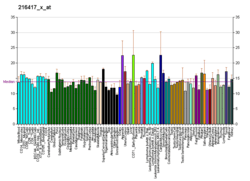HOXB9
Homeobox protein Hox-B9 is a protein that in humans is encoded by the HOXB9 gene.[5][6][7]
Function
This gene is a member of the Abd-B homeobox family and encodes a protein with a homeobox DNA-binding domain. It is included in a cluster of homeobox B genes located on chromosome 17. The encoded nuclear protein functions as a sequence-specific transcription factor that is involved in cell proliferation and differentiation. Increased expression of this gene is associated with some cases of leukemia, prostate cancer and lung cancer.[7]
Interactions
HOXB9 has been shown to interact with BTG2[8] and BTG1.[8]
See also
References
- 1 2 3 GRCh38: Ensembl release 89: ENSG00000170689 - Ensembl, May 2017
- 1 2 3 GRCm38: Ensembl release 89: ENSMUSG00000020875 - Ensembl, May 2017
- ↑ "Human PubMed Reference:".
- ↑ "Mouse PubMed Reference:".
- ↑ McAlpine PJ, Shows TB (August 1990). "Nomenclature for human homeobox genes". Genomics. 7 (3): 460. PMID 1973146. doi:10.1016/0888-7543(90)90186-X.
- ↑ Scott MP (December 1992). "Vertebrate homeobox gene nomenclature". Cell. 71 (4): 551–3. PMID 1358459. doi:10.1016/0092-8674(92)90588-4.
- 1 2 "Entrez Gene: HOXB9 homeobox B9".
- 1 2 Prévôt D, Voeltzel T, Birot AM, Morel AP, Rostan MC, Magaud JP, Corbo L (January 2000). "The leukemia-associated protein Btg1 and the p53-regulated protein Btg2 interact with the homeoprotein Hoxb9 and enhance its transcriptional activation". J. Biol. Chem. 275 (1): 147–53. PMID 10617598. doi:10.1074/jbc.275.1.147.
Further reading
- Deguchi Y, Kehrl JH (1991). "Selective expression of two homeobox genes in CD34-positive cells from human bone marrow". Blood. 78 (2): 323–8. PMID 1712647.
- Peverali FA, D'Esposito M, Acampora D, Bunone G, Negri M, Faiella A, Stornaiuolo A, Pannese M, Migliaccio E, Simeone A (1990). "Expression of HOX homeogenes in human neuroblastoma cell culture lines". Differentiation. 45 (1): 61–9. PMID 1981366. doi:10.1111/j.1432-0436.1990.tb00458.x.
- Giampaolo A, Acampora D, Zappavigna V, Pannese M, D'Esposito M, Carè A, Faiella A, Stornaiuolo A, Russo G, Simeone A (1989). "Differential expression of human HOX-2 genes along the anterior-posterior axis in embryonic central nervous system". Differentiation. 40 (3): 191–7. PMID 2570724. doi:10.1111/j.1432-0436.1989.tb00598.x.
- Acampora D, D'Esposito M, Faiella A, Pannese M, Migliaccio E, Morelli F, Stornaiuolo A, Nigro V, Simeone A, Boncinelli E (1989). "The human HOX gene family". Nucleic Acids Res. 17 (24): 10385–402. PMC 335308
 . PMID 2574852. doi:10.1093/nar/17.24.10385.
. PMID 2574852. doi:10.1093/nar/17.24.10385. - Boncinelli E, Acampora D, Pannese M, D'Esposito M, Somma R, Gaudino G, Stornaiuolo A, Cafiero M, Faiella A, Simeone A (1989). "Organization of human class I homeobox genes". Genome. 31 (2): 745–56. PMID 2576652. doi:10.1139/g89-133.
- Apiou F, Flagiello D, Cillo C, Malfoy B, Poupon MF, Dutrillaux B (1996). "Fine mapping of human HOX gene clusters". Cytogenet. Cell Genet. 73 (1-2): 114–5. PMID 8646877. doi:10.1159/000134320.
- Ohnishi K, Tobita T, Sinjo K, Takeshita A, Ohno R (1998). "Modulation of homeobox B6 and B9 genes expression in human leukemia cell lines during myelomonocytic differentiation". Leuk. Lymphoma. 31 (5-6): 599–608. PMID 9922051. doi:10.3109/10428199809057620.
- Prévôt D, Voeltzel T, Birot AM, Morel AP, Rostan MC, Magaud JP, Corbo L (2000). "The leukemia-associated protein Btg1 and the p53-regulated protein Btg2 interact with the homeoprotein Hoxb9 and enhance its transcriptional activation". J. Biol. Chem. 275 (1): 147–53. PMID 10617598. doi:10.1074/jbc.275.1.147.
- Calvo R, West J, Franklin W, Erickson P, Bemis L, Li E, Helfrich B, Bunn P, Roche J, Brambilla E, Rosell R, Gemmill RM, Drabkin HA (2000). "Altered HOX and WNT7A expression in human lung cancer". Proc. Natl. Acad. Sci. U.S.A. 97 (23): 12776–81. PMC 18840
 . PMID 11070089. doi:10.1073/pnas.97.23.12776.
. PMID 11070089. doi:10.1073/pnas.97.23.12776. - de Pinieux G, Legrier ME, Poirson-Bichat F, Courty Y, Bras-Gonçalves R, Dutrillaux AM, Némati F, Oudard S, Lidereau R, Broqua P, Junien JL, Dutrillaux B, Poupon MF (2001). "Clinical and experimental progression of a new model of human prostate cancer and therapeutic approach". Am. J. Pathol. 159 (2): 753–64. PMC 1850557
 . PMID 11485933. doi:10.1016/S0002-9440(10)61746-4.
. PMID 11485933. doi:10.1016/S0002-9440(10)61746-4. - Shen WF, Krishnan K, Lawrence HJ, Largman C (2001). "The HOX homeodomain proteins block CBP histone acetyltransferase activity". Mol. Cell. Biol. 21 (21): 7509–22. PMC 99922
 . PMID 11585930. doi:10.1128/MCB.21.21.7509-7522.2001.
. PMID 11585930. doi:10.1128/MCB.21.21.7509-7522.2001. - Kosaki K, Kosaki R, Suzuki T, Yoshihashi H, Takahashi T, Sasaki K, Tomita M, McGinnis W, Matsuo N (2002). "Complete mutation analysis panel of the 39 human HOX genes". Teratology. 65 (2): 50–62. PMID 11857506. doi:10.1002/tera.10009.
- Hori Y, Gu X, Xie X, Kim SK (2005). "Differentiation of insulin-producing cells from human neural progenitor cells". PLoS Med. 2 (4): e103. PMC 1087208
 . PMID 15839736. doi:10.1371/journal.pmed.0020103.
. PMID 15839736. doi:10.1371/journal.pmed.0020103. - Rual JF, Venkatesan K, Hao T, Hirozane-Kishikawa T, Dricot A, Li N, Berriz GF, Gibbons FD, Dreze M, Ayivi-Guedehoussou N, Klitgord N, Simon C, Boxem M, Milstein S, Rosenberg J, Goldberg DS, Zhang LV, Wong SL, Franklin G, Li S, Albala JS, Lim J, Fraughton C, Llamosas E, Cevik S, Bex C, Lamesch P, Sikorski RS, Vandenhaute J, Zoghbi HY, Smolyar A, Bosak S, Sequerra R, Doucette-Stamm L, Cusick ME, Hill DE, Roth FP, Vidal M (2005). "Towards a proteome-scale map of the human protein-protein interaction network". Nature. 437 (7062): 1173–8. PMID 16189514. doi:10.1038/nature04209.
- Kimura K, Wakamatsu A, Suzuki Y, Ota T, Nishikawa T, Yamashita R, Yamamoto J, Sekine M, Tsuritani K, Wakaguri H, Ishii S, Sugiyama T, Saito K, Isono Y, Irie R, Kushida N, Yoneyama T, Otsuka R, Kanda K, Yokoi T, Kondo H, Wagatsuma M, Murakawa K, Ishida S, Ishibashi T, Takahashi-Fujii A, Tanase T, Nagai K, Kikuchi H, Nakai K, Isogai T, Sugano S (2006). "Diversification of transcriptional modulation: large-scale identification and characterization of putative alternative promoters of human genes". Genome Res. 16 (1): 55–65. PMC 1356129
 . PMID 16344560. doi:10.1101/gr.4039406.
. PMID 16344560. doi:10.1101/gr.4039406.
External links
- HOXB9 protein, human at the US National Library of Medicine Medical Subject Headings (MeSH)
This article incorporates text from the United States National Library of Medicine, which is in the public domain.
This article is issued from
Wikipedia.
The text is licensed under Creative Commons - Attribution - Sharealike.
Additional terms may apply for the media files.




